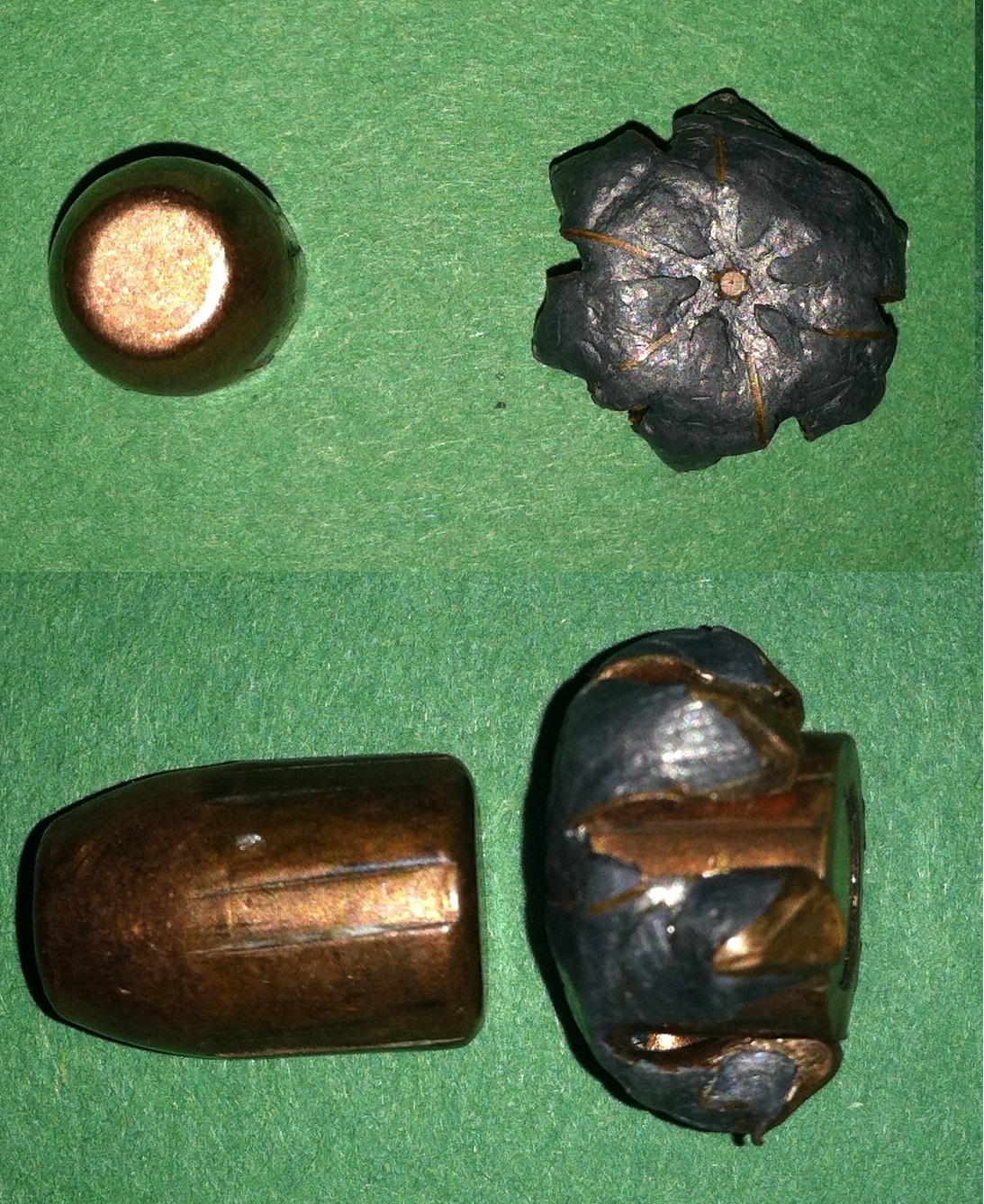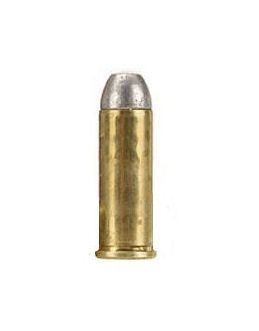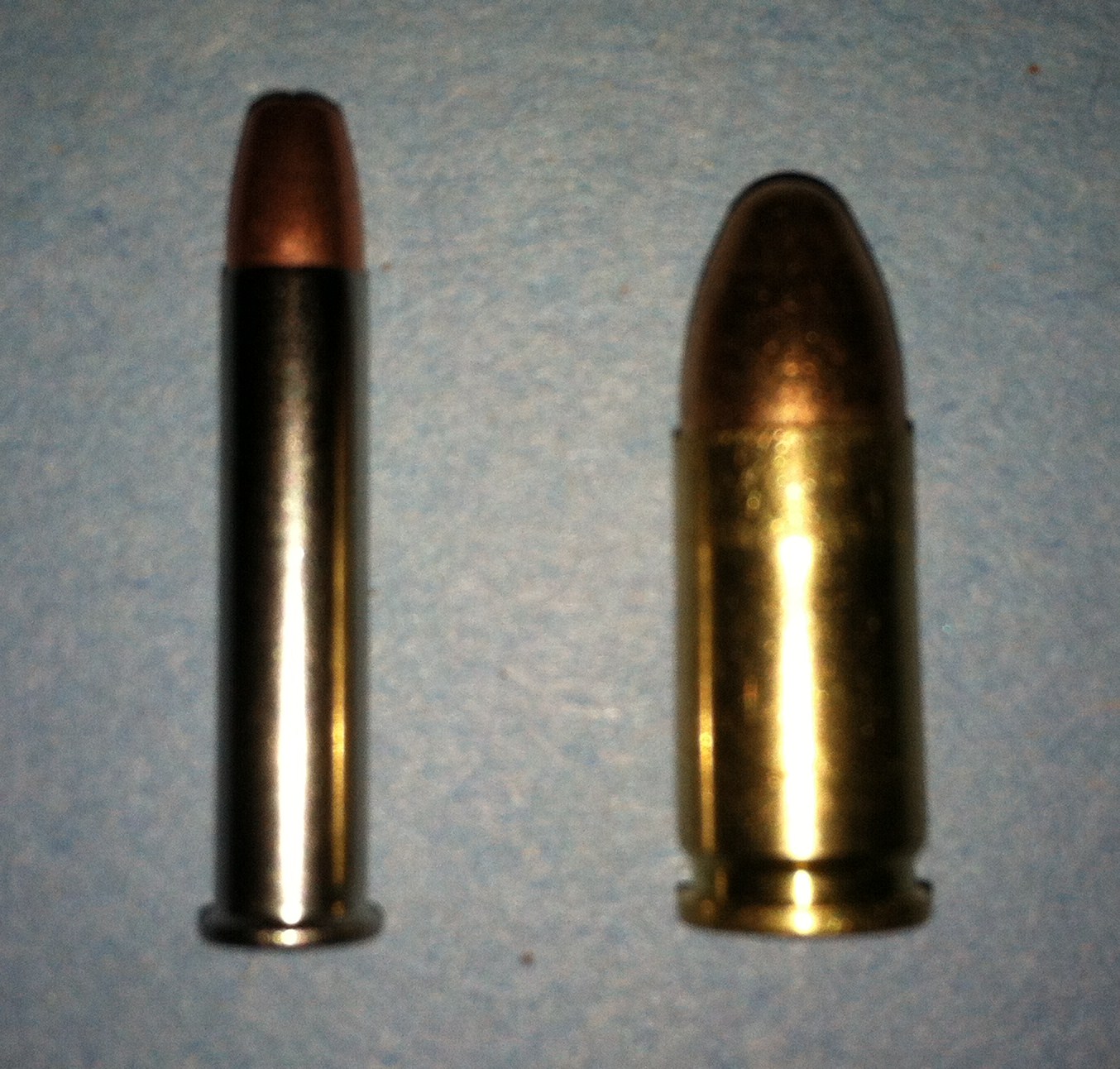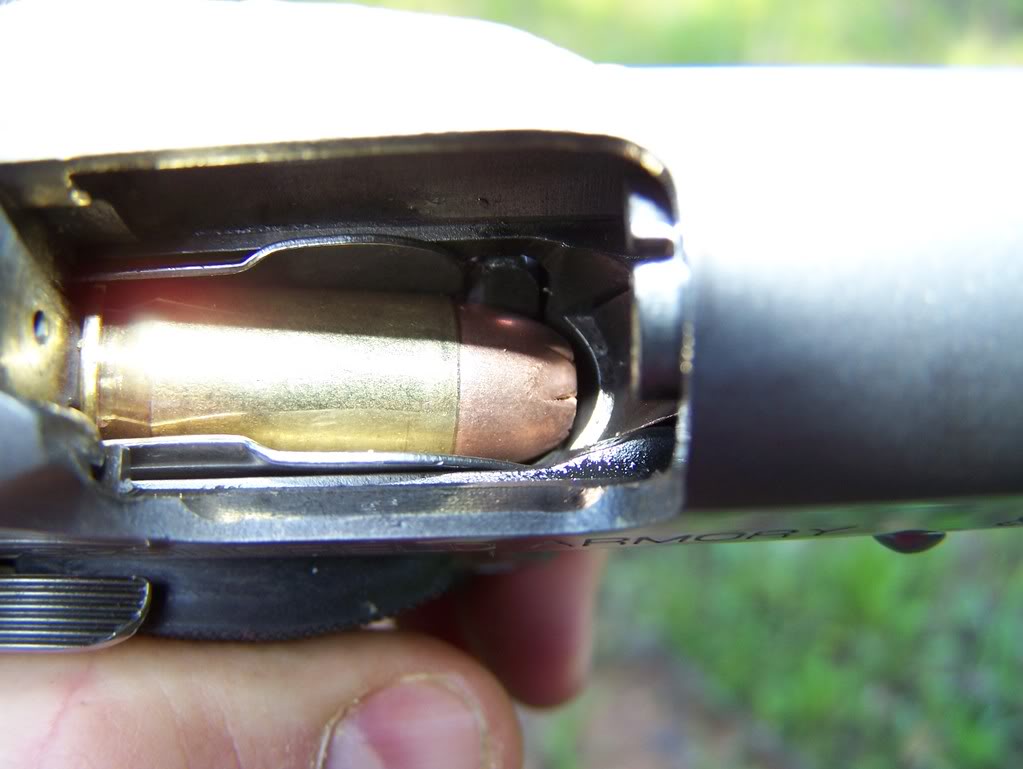
Fired 9mm FMJ (left) and fired 9mm defensive bullet. Difference in size caused by expansion is obvious. Photo: author
This all started when I was doing some research into ammunition and watching videos to see what was out there. I had been carrying the same type of ammunition for a while and was getting ready to swap it out. I wanted to see if something else had come out that I might be interested in. There are a lot of videos on the subject, and many people film shooting ballistics gel. People had commented on these videos that they prefer to carry .45 ACP full metal jacket in their concealed handguns. These comments intrigued me.
The History
I began to wonder why someone would prefer these rounds after seeing the tests, so I did my own research. In the late 1800s, the creation of smokeless gunpowder took over the firearms world. With the increase in power of this new smokeless powder, bullet design had to change as well, since the soft lead alloys used to make the bullets of the time did not hold up well to the increased velocity and pressures. The idea of coating the bullet with another metal that would keep it all together came around and solved the problem. Unfortunately it actually caused the problem of over-penetration as well.
Combined with the lower velocities, the soft lead alloys used in previous bullets would naturally expand somewhat when hitting a target rather than simply going straight through it. The new full metal jacket rounds did not expand at all and did minimal damage to the target. Hunters began complaining about the effectiveness of the new ammunition. Sure, it was more powerful, but it would simply go through a deer or other animal without causing an injury that would incapacitate it enough for a sure kill. In the Philippine-American War, our soldiers experienced this same problem with their .38-caliber pistols. Fighting against a determined Moro Warrior force, the .38-caliber rounds did not incapacitate the enemy, who continued to fight. A solution was needed.
Around this time, the British had been experimenting with ammunition after finding similar issues with their new battle rifle chambered in .303. The solution was the so-called “dumdum” round. This was basically what we would today call a jacketed soft point. The jacketing is removed from the tip of the bullet, exposing the soft lead core to allow for better expansion than that of a full metal jacket. The German government protested these rounds, stating that they were inhumane, and in 1899 The Hague Convention outlawed expanding ammunition in international warfare. Although the United States was not a member of The Hague Convention, we complied with this rule.
Shortly thereafter, in 1904, the U.S. began seeking a new pistol to issue to the cavalry. With the issues we had experienced with smaller bullets, it was specified that the minimum caliber was to be .45. John Browning fulfilled this request with the design of the .45 ACP cartridge and later the M1911 pistol. Both of these were genius designs for that time and solved the issues at hand. The .45 ACP offered the power needed, with a heavier, slower-moving bullet that did not over-penetrate and had a much greater effect on the target. The round was in compliance with The Hague Convention, and both the round and the pistol served the military well for 75 years.
Modern Technology
Fast forward to the modern day and the rules of warfare have not changed. Expanding ammunition is still outlawed in warfare, and full metal jacket rounds are in use. In the private sector and law enforcement community, much has changed. The technology in bullet design has grown by leaps and bounds. We have specialized ammunition for many hunting applications and for self-defense.
First we must look at the ammunition being the right tool for the job. If involved in a self-defense situation where the use of deadly force is needed to protect us from grave bodily injury or death, we want to be able to stop the threat as efficiently as possible. Modern defensive ammunition gives us the best chance of this. The incapacitating effect that these rounds have is amplified many times over.
Field Test
We recently completed a simple test, firing a .45 ACP full metal jacket and a .22 WMR Speer Gold Dot self-defense round into one-gallon water jugs. Showing people video of this, we even told them it was a demonstration of the power difference between 9mm and .45 ACP. We then asked them to pick out which round was .45 ACP and which 9mm. All were surprised to find they had selected the .22 WMR as being the .45 ACP. This began a great discussion in class on the importance of the bullet design versus raw power. To give you one statistic, the .22 WMR is rated by the manufacturer to have 99 ft-lbs of energy at the muzzle, as compared to 352 ft-lbs for the .45 ACP.
I am in no way suggesting that a .45 defensive round would have been even a close call against the .22 WMR defensive round. But I am suggesting that the design of the bullet made the .22 WMR outperform the .45 ACP full metal jacket. We can only imagine the increased effectiveness the combination of more power and the bullet design would have.
The result of this is that a person can carry a slightly less powerful handgun and have it be a viable self-defense weapon. Many people cannot handle the recoil of a .45 ACP, and some who say they can have been practicing in target-shooting scenarios, not defensive-style shooting. Even if they can manage the recoil in a semi-efficient manner, they still cannot fire as quickly and effectively as they can a 9mm or similar caliber. Many people think a .45 ACP is a huge increase in power versus the 9mm round. Again I believe this comes from the mindset of not being able to use defensive ammunition. Many in the military hated the idea of switching from the 1911 to the Beretta 92 in 1986. They claimed the 9mm was not effective enough. And in part they were right. A 9mm full metal jacket has the same problems that were experienced with our ancestors’ .38-caliber pistols during the Philippine-American War. The smaller, faster-moving projectile goes through the target with “minimal” damage and less chance of incapacitating.
Although I can agree with this in that context, it does not apply to civilian self-defense. A 9mm defensive round will actually outperform the .45 ACP full metal jacket. Beyond that in the civilian and law enforcement worlds, getting to fire those shots more quickly while still maintaining the level of precision needed to get effective hits gets you out of danger sooner. And that’s our goal.
I have heard many instructors claim the reason we carry defensive ammunition is that it is “safer.” This is a great statement to try to make the subject more politically correct. The thought is that defensive ammunition does not over-penetrate and therefore will not exit and hit an innocent person. I personally do not like this thought process, as it creates a false sense that it is ok not to assure a proper backstop in the middle of a defensive encounter. Even quality defensive ammunition can fail to expand, negating this argument. But I will say that the combination of being able to lower recoil but still have an effective round can aid in safety by allowing the average student to maintain accuracy better while firing rapidly. Remember that regardless of how well a bullet is designed, it will not stop until it hits something or someone that makes it stop.
Conclusions
After my research and testing, I have come to the conclusion there is one main reason people were commenting that they prefer full metal jacket over defensive ammunition. They fall into the “it’s always been that way” crowd.
Many of these people are 1911 fanatics whose minds may never change. The fact is that, for their time, John Browning’s designs were genius. But the two-piece feed ramp of the 1911 does not handle hollow point ammunition well. It was not designed for that. Many people will never change their mind, regardless of what they read here (if they have even read this far). They will not allow themselves to believe there is any room for improving on the “perfection” that is the 1911 or the .45 ACP cartridge. I do have to mention that, ironically, Browning himself died at a workbench working on a 9mm cartridge. As innovative as he was, I believe he would be embracing modern designs and even working on new designs to improve them.
Regardless of what caliber or design you choose in a firearm, take the time to consider the ammunition you carry in it. Buy extra ammunition and test fire it. Put it through a small torture test to be sure it functions properly in your firearm. Your life may count on that ammunition someday, and ending the threat as soon as possible can make the difference.




One other reason that the military uses FMJ instead of hollow-point ammo is that tactically, we don't want to kill the enemy. One dead soldier only removes one combatant from the battlefield. One wounded soldier removes an average of 8 personnel from the battlefield. They require people to remove them from the field, transport them to medical facilities, people to triage, and people to treat them long-term. The more people you injure, the more you can overwhelm their logistics. They can step over a dead soldier and ignore them until after the battle. That's much harder to do with a wounded one, one that they need later. That tactical thinking was also part of the decision to switch to the 5.56 round; devastating wounds, not necessarily fatal.
This article comes at an interesting time. I am a staunch 1911 carrier. Because of my love of that platform I have carried .45acp ammunition. However in the late 80's my Police Dept. went to 9mm duty pistols. I carried a 9mm pistol for the next 17 years. I had recently purchased a 1911 in 9mm and decided on a "home brewed" test. Needless to say there was nothing "scientific" about my test but I had been trying some of the new Sig brand of JHPs. I lined up six one gallon milk jugs filled with water and fired one Sig 124 gr. 9mm into the line of jugs and then followed by replacing the damaged jug and firing one rd. of the Sig 200 gr. jhp's in .45 acp. Both rds. were fired from 4.25 " barreled 1911's. The results were amazing. Both rounds basically blew up 2 jugs and penetrated into the third. The .45acp round expanded perfectly, as did the 9mm. The .45acp round measured .72" on my caliper and the 9mm expanded to .68". My unscientic test, on an extremely small sample, showed very minimal difference between these two particular rounds.
Couple of thoughts . . . these days, so long as they function 100% in YOUR gun, the premium defensive or duty ammo lines from major manufacturers are all going to produce good results. Same for carefully prepared handloads, though there's a LOT of disagreement about the wisdom of using them in defensive situations from a legal standpoint. This isn't 1960, so there's a lot of really GOOD factory ammo to choose from on the market. I have doubts about some of the trick ammo from small or "boutique" manufacturers, hence my emphasis on "major" manufacturers. I'd avoid the "weird" stuff. As to caliber - the biggest YOU can handle is probably the best. Now, depending on how I'm dressed, I'll carry either a 9mm, a .45, or a .357 J-frame. (And yes, I DO practice with each one!) Finally, don't sneer at small cartridges - maybe a .22LR/.22 Mag is all a person (for example, an arthritic senior citizen) can handle. While I personally would NOT prefer a rimfire, the difference between a 9mm and a .45 is a lot smaller than the difference between bare hands and a .22.
Let's discuss recoil or perceived recoil. I question many manufacturers who make hotter loads for 9MM defensive ammo. If you can't control your firearm, what sense does it make to have hotter loads? I have been teaching many ladies lately and I teach them a number of things that hopefully can save their lives. One important item is that most conflicts come at less than 10 yards. Most of those at less than 7 yards. Look at the impact of a subsonic (lower recoil) with a hollow point at 7 yards. Very effective on your target. PLUS, the major benefit is you are back on target much faster. Please consider this. My carry is 9MM with subsonic hollow points and it allows me to put 2-3 shots at 7 yards into the thoracic cavity consistently fast. I never want to shoot a person, ever. But if I am trapped into defending my wife, kids or grandkids, I feel my training, practice and more control over my firearm allows me to protect the ones I love.
I have been firing full metal jacket for target practice and carrying hollow points for self defense for the last three years. The other day, my friend told me that it was common practice in law enforcement to change out your carry ammo every year. He also pointed out that since I had never fired my hollow points, we had no idea if my Glocks would feed right. So I fired off my older hollow points that day and now am certain that both of my Glocks feed hollow point perfectly. I would recommend that, although hollow points are more expensive, you should test fire your personal defense weapons with the ammo that you are going to be carrying.
My concern is a personal defense moment is always unexpected, which means training for all scenarios is a must. However, I will be most likely limited to one concealed firearm. Therefore would it make sense to have a magazine with a mix of JHP and FMJ because the situation will be unknown till,it happens. Being able to deliver in an array of ammo that addresses a target in which you did not plan for beforehand seems better than using one type of ammo against a target in which your selected ammo was not totally effective. I selected .357 sig for its top rated fps, accuracy and never an issue on feeding just by its design, Please provide your insights and comments, all information is most appreciated.
Should have tested the 45 ACP Glaser Blue Safety Slug 145gr. +P Ammo.
I am concerned if you end up in court the use of defensive ammunition like the Black Talon will be fodder for the prosecution. A way to say that the defendant was trying to inflict maximum damage. The jury is aware of this ammunition and others like them. Do you think this is a relevant point?
I thought you were comparing the 45ACP to the 9mm, where did the 22WMR come from?
I would be more concerned of the expansion between a hollow point and a solid of the same caliber.